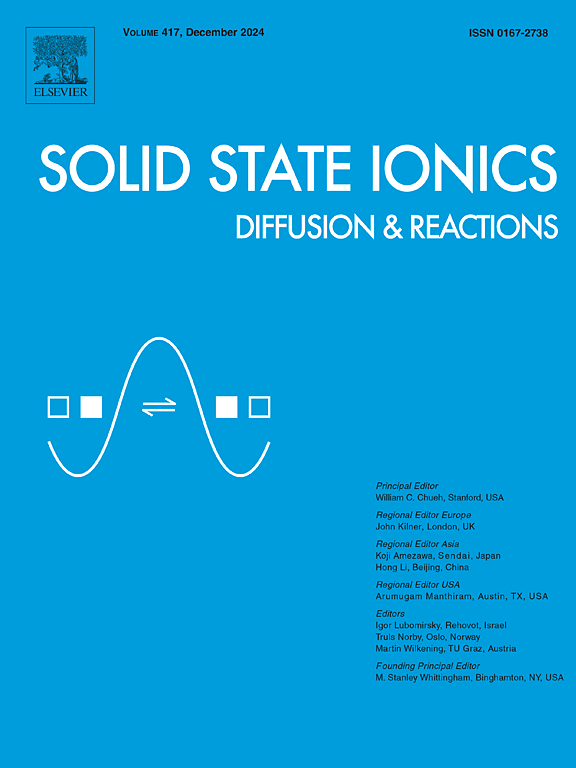Interface design for enhancing the performance of solid oxide cell contact layers between interconnects and solid oxide cells
IF 3
4区 材料科学
Q3 CHEMISTRY, PHYSICAL
引用次数: 0
Abstract
In a planar solid oxide cell (SOC) stack, the assembly consists of metal materials and ceramic cells in which various ceramics (such as electrolytes and electrodes) are laminated in multiple layers. Notably, the interface between the air-side electrode and the coated interconnector plays a critical role in determining the performance of the SOC stack, during the manufacturing process. Unlike other SOC cell components, which are typically sintered at high temperature (e.g., over 1000 °C), the contact material at this interface is constructed during the SOC stacking process, generally at a lower temperature range of 750 °C–850 °C. Consequently, the contact material connecting the air electrode and the coated interconnector must exhibit high adhesion and low electrical resistance at 800 °C. In this study, a low-resistance, highly adhesive interface between the air electrode and the interconnector in the SOC stack is developed through diffusion bonding and metal addition at lower temperatures. Co![]() Mn spinel oxides are employed as both the contact material and the coating layer, and a concentration gradient is achieved in the contact material and coating layer, with high adhesion and low resistance facilitated by the interdiffusion of Co and Mn. The heat generated during the oxidation of the added metallic Co promotes sintering, further enhancing adhesion. The diffusion bonding interface and the metal-added diffusion bonding interface were subjected to continuous durability tests over 10,000 h, and no deterioration was observed.
Mn spinel oxides are employed as both the contact material and the coating layer, and a concentration gradient is achieved in the contact material and coating layer, with high adhesion and low resistance facilitated by the interdiffusion of Co and Mn. The heat generated during the oxidation of the added metallic Co promotes sintering, further enhancing adhesion. The diffusion bonding interface and the metal-added diffusion bonding interface were subjected to continuous durability tests over 10,000 h, and no deterioration was observed.
用于提高固体氧化物电池互连和固体氧化物电池之间接触层性能的界面设计
在平面固体氧化物电池(SOC)堆叠中,组件由金属材料和陶瓷电池组成,其中各种陶瓷(如电解质和电极)被层压成多层。值得注意的是,在制造过程中,空气侧电极和涂层互连器之间的界面在决定SOC堆栈的性能方面起着关键作用。与其他通常在高温下烧结(例如,超过1000°C)的SOC电池组件不同,该界面上的接触材料是在SOC堆叠过程中构建的,通常在750°C - 850°C的较低温度范围内。因此,连接空气电极和涂层互连器的接触材料必须在800°C时表现出高附着力和低电阻。在本研究中,通过在较低温度下的扩散键合和金属添加,在SOC堆叠中的空气电极和互连器之间建立了一个低电阻,高粘附性的界面。采用普通尖晶石氧化物作为接触材料和包覆层,在接触材料和包覆层中实现了浓度梯度,Co和Mn的相互扩散促进了高附着力和低电阻。添加的金属Co氧化过程中产生的热量促进了烧结,进一步增强了附着力。扩散连接界面和添加金属的扩散连接界面进行了超过10,000 h的连续耐久性试验,未观察到任何劣化。
本文章由计算机程序翻译,如有差异,请以英文原文为准。
求助全文
约1分钟内获得全文
求助全文
来源期刊

Solid State Ionics
物理-物理:凝聚态物理
CiteScore
6.10
自引率
3.10%
发文量
152
审稿时长
58 days
期刊介绍:
This interdisciplinary journal is devoted to the physics, chemistry and materials science of diffusion, mass transport, and reactivity of solids. The major part of each issue is devoted to articles on:
(i) physics and chemistry of defects in solids;
(ii) reactions in and on solids, e.g. intercalation, corrosion, oxidation, sintering;
(iii) ion transport measurements, mechanisms and theory;
(iv) solid state electrochemistry;
(v) ionically-electronically mixed conducting solids.
Related technological applications are also included, provided their characteristics are interpreted in terms of the basic solid state properties.
Review papers and relevant symposium proceedings are welcome.
 求助内容:
求助内容: 应助结果提醒方式:
应助结果提醒方式:


